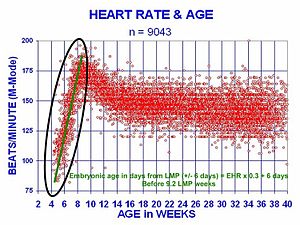Early development
Main article: Heart development
The mammalian heart is derived from embryonic mesoderm germ-layer cells that differentiate after gastrulation into mesothelium, endothelium, and myocardium. Mesothelial pericardium forms the outer lining of the heart. The inner lining of the heart, lymphatic and blood vessels, develop from endothelium. Heart muscle is termed myocardium.[2]From splanchnopleuric mesoderm tissue, the cardiogenic plates develops cranially and laterally to the neural plate. In the cardiogenic plates, two separate angiogenic cell clusters form on either side of the embryo. The cell clusters coalesces to form an endocardial tube continuous with a dorsal aorta and a vitteloumbilical vein. As embryonic tissue continues to fold, the two endocardial tubes are pushed into the thoracic cavity, begin to fuse together, and complete the fusing process at approximately 21 days.[3]
At 21 days after conception, the human heart begins beating at 70 to 80 beats per minute and accelerates linearly for the first month of beating.

No comments:
Post a Comment